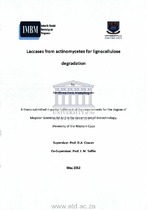| dc.contributor.advisor | Cowan, D.A. | |
| dc.contributor.author | Mamphogoro, Tshifhiwa Paris | |
| dc.date.accessioned | 2022-03-03T07:26:28Z | |
| dc.date.available | 2022-03-03T07:26:28Z | |
| dc.date.issued | 2012 | |
| dc.identifier.uri | http://hdl.handle.net/11394/8788 | |
| dc.description | >Magister Scientiae - MSc | en_US |
| dc.description.abstract | Lignocellulose has a complex structure composed mainly of lignin, hemicellulose and cellulose. Several enzymes are needed for the degradation of lignocellulose into simple sugars. Actinomycetes are known to produce laecases which are able to degrade lignin. Laccase activities were detected in actinomycete strains MS26 isolated from soil collected from the Zambian Copperbelt and DFNR17 isolated from soil collected from a New Zealand farm. Morphological .studies showed that the strains produced extensively branched substrate mycelia and aerial hyphae. Micromorphological characteristics were consistent with the assignment of these strains to the genus Streptomyces. Isolates were found to be mesophiles, with growth occurring in a temperature range of 16 and 45°C. Optimal growth occurred at temperatures between 30 and 37°C. Analysis of the 16S rRNA gene sequences of the strains showed that strain MS26 had the highest sequence similarity (99%) to Streptomyces atrovirens strain NRRLB-16357 and Streptomyces viridodiastaticus strain IFO 13106. Strain DFNR17 had the highest 16S rRNA gene sequence similarity (99%) to Streptomyces althioticus strain KCTC9752. The strains shared several physiological and
biochemical characteristics with their closest neighbours which, along with 16S rRNA gene sequences analysis, confirmed that the strains were members of the genus Streptomyces. Attempts to identify the laecase genes from these isolates by screening a fosmid library failed. Subsequently isolates were screened by PCR using laccase-like cooper oxidase degenerate primers designed from several Streptomyces strains. A 300 bp amplicon was obtained from both isolates. Phylogenetic analysis was performed and both amplicons from strains MS26 and DFNR17 had the highest similarities with the copper oxidase gene from Streptomyces griseoflavus strain Tu4000. Therefore it is probable that the laecase activity observed for these strains is due to the activity of copper oxidase gene products. | en_US |
| dc.language.iso | en | en_US |
| dc.publisher | University of the Western Cape | en_US |
| dc.subject | Lignocellulose | en_US |
| dc.subject | Hemicellulose | en_US |
| dc.subject | Micromorphological | en_US |
| dc.subject | Streptomyces | en_US |
| dc.subject | Viridodiastaticus | en_US |
| dc.subject | Actinomycetes | en_US |
| dc.subject | Althioticus | en_US |
| dc.subject | Griseoflavus | en_US |
| dc.title | Laccases from actinomycetes for lignocellulose degradation | en_US |
| dc.rights.holder | University of the Western Cape | en_US |

